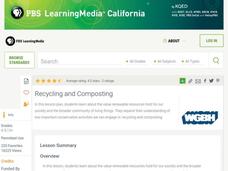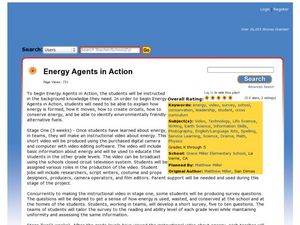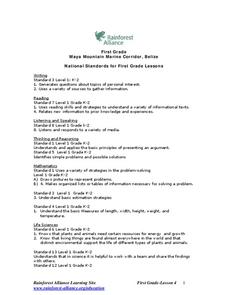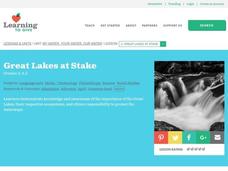Curated OER
In the Company of Whales
Students examine whales and how they migrate. In this whale activity students research whales and their migration patterns.
Curated OER
Recycle, Reduce, Reuse and Save a Tree
Students examine how to save and protect trees. For this conservation lesson, students read books about the usefulness of trees, write ideas in their journals about how trees can be used, and make a book of ways to protect trees.
Curated OER
Insect Conservation
Students make a diorama. In this insect lesson, students review what they know and what they need to know about insects. Students define conservation, discuss why it is important to conserve insects, and make an insect diorama.
Curated OER
Treasures in Jeopardy
Students study how coral reefs can be protected from humans and their activities. In this conservation activity students explain the benefits of coral reefs and what humans can do to help protect them.
Curated OER
Kids for Conservation: Animal Unit
Students discuss animal needs and characteristics. In this animal mini-unit, students complete three activities studying different animals, their needs, how they have evolved, and how to protect them.
Curated OER
Pollution is Not a Solution
Students explore the environment by completing science worksheets in class. In this water conservation lesson, students identify ways water is used in our society and how we abuse the privilege. Students discuss methods to reduce water...
Curated OER
What happens to water before we use it?
Students examine how water is treated prior to becoming available for human consumption. In this water treatment lesson, students conduct an experiment in which they filter water. Students formulate a hypothesis, test, analyze data, and...
Curated OER
Recycling and Composting
Young scholars investigate the reasons for and processes of Recycling and Composting. In this environmental lesson, students learn to identify renewable and nonrenewable resources and then practice recycling by making recycled...
Curated OER
Uses of Water
Students plan for a water shortage in their area. In this water lesson, students analyze water usage and plan and share a reduction plan. Groups share their results and calculate the averages. Students analyze how water...
Curated OER
Energy Agents in Action
Students share information about energy use and conservation. In this energy use instructional activity, students work as a production team to make an instructional video about basic energy information. They develop a short survey about...
Curated OER
What Makes a Home "Energy Efficient"?
Students research and report the costs and benefits of making their own homes more energy efficient. In this energy conservation instructional activity, students explore energy efficient technologies and design over several days. They...
Curated OER
Who Takes Care of the Maya Forest Corridor?
First graders study the animals in the Maya Forest Reserve. In this conservation lesson, 1st graders create a graph to compare the environment of animals to their own. They design a 3D model of these two environments.
Curated OER
Water Conservation
Students explore types of water reserves. In this water conservation lesson plan, students brainstorm ways water are used in their homes. Students use a graduated cylinder to simulate the amount of water on Earth and the amount that...
Curated OER
Paper Makers
Students make recycled paper out of scrap paper, water, and leaves. In this natural resources lesson plan, students learn about conservation of the forest and how we can use recycled paper to fuel our paper supply.
Curated OER
Simulation: Yum, Yum Trees Simulation: Yum Yum Trees Conservation of Resources
Students weigh the uses of the yum yum tree against the problem of conserving them. In this conservation lesson, groups of students discuss and make suggestion to conserve the yum, yum trees. Students apply knowledge to renewable and...
Curated OER
Great Lakes at Stake
Students explore conservation of the Great Lakes. In this geography and ecology lesson, students identify the Great Lakes on a map and view a video depicting the history and importance of these lakes. Students work in groups to research...
Curated OER
Three R's to Environmental Stewardship: Earth Day
Students explore the ways to conserve our natural resources. In this recycling, reusing, and reducing lesson students read Dinosaurs to the Rescue and apply their findings to learning ways to conserve resources. Students complete a...
Curated OER
What Have We Done?
Students investigate the effect of dams on the ecosystem. In this environmental instructional activity, students read case studies on the Aswan Dam and the Colorado River Basin and construct a T-chart to compare the effects on the region.
Curated OER
Water Conservation
Students identify ways to conserve water. In this environmental lesson, students use a water use checklist to identify how much water they use in one day. Students analyze the data and brainstorm ways to conserve water.
Curated OER
Measure It Up!
Students investigate the states that water may take. In this physical science lesson, students read the book, Water: Up, Down, and All Around and recall the states of water from the book. Students examine how water takes the shape of its...
Curated OER
"Water Has Many Uses" Mini-unit
Young scholars understand the importance of water as a resource in our lives. In this water mini-unit students recognize that not all countries have water available as we do. Young scholars discuss and explain a plan for responsibilities...
Curated OER
"Water is Life" Global Water Awareness
Young scholars examine and calculate the percentage of potable water remaining on the earth. In this ecology and geography lesson, students brainstorm the main factors affecting water distribution. Young scholars use mathematical problem...
Curated OER
Activist Survey
In this stewardship worksheet, learners determine what actions and behaviors help to keep an environment healthy. This worksheet has 15 true or false questions.
Curated OER
Environmental Issues
In this environmental issues activity, students respond to 14 different types of questions divided into 3 sections. First, they define global warming and give an example of what they can do to slow it. Then, students define 4 terms using...























